About WORLD'S POPULAR musical FORMS
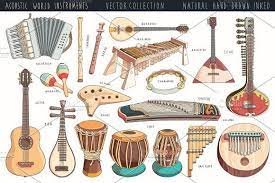
What is the origin of jazz?
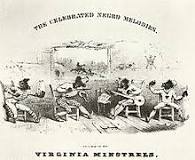
Jazz is a music genre that originated in the African-American communities of New Orleans, Louisiana in the late 19th and early 20th centuries, with its roots in blues and ragtime. Since the 1920s Jazz Age, it has been recognized as a major form of musical expression in traditional and popular music.
Where did jazz originate in Africa?
Jazz is often thought of as being founded on the musical traditions of West Africa (rhythm, “feel”, blues) and Europe (harmonic chords, variety of instruments). Early jazz also incorporated church hymns, slave songs, field chants, and cuban-style rhythm.
What is marabi in Mapeh?
Marabi. Possessing a keyboard style combining American Jazz, ragtime and blues and African Roots. Marabi. It is characterized by simple chords in varying vamping patterns and repetitive harmony over an extended period of time to allow the dancers more time on the dance floor. Reggae.
What are the vocal form of African music?
Terms in this set (5)
- Maracatu. first surfaced in the African state of Pernambuco, combining the strong rhythms of African percussion instruments with Portuguese melodies.
- Blues. a musical form of the late 19th century that has had deep roots in African-American communities. ...
- Soul. ...
- Spiritual. ...
- Call and Response.
It was very popular in Africa. The dance was popularized by soukous music videos, as well as the videos of Kanda Bongo Man, Pepe Kalle, Viva La Musica, and other Congolese musicians. For the first time in Congo, all the groups adopted these dance steps.
Mbira was used in ceremonial functions such as weddings, funerals, and in honour of significant people, as well as for religious purposes, to call on spirits and seek their advice.
Where did kwaito music originated?
Kwaito music is a style of popular music that originated in South Africa during the 1990s. The genre draws upon several Western music styles, including electronic dance music and hip-hop, for its unique combination of house beats, looped samples, and spoken/shouted vocals.
Blues
Blues is a music genre and musical form which originated in the Deep South of the United States around the 1860s by African-Americans from roots in African-American work songs and spirituals. Blues incorporated spirituals, work songs, field hollers, shouts, chants, and rhymed simple narrative ballads.
What does the term the blues mean?
Feeling of sadness or depression
: a feeling of sadness or depression I've got (a case of) the blues.
Is blues happy or sad music?
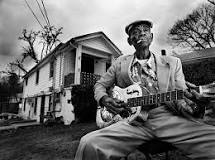
Blues music tends to be about love and sadness, built off a simple I-IV-V 12-bar chord progression, contains very down-to-earth lyrics, and evolves with time.
Why are the blues called blues?
The name of this great American music probably originated with the 17th-century English expression “the blue devils,” for the intense visual hallucinations that can accompany severe alcohol withdrawal. Shortened over time to “the blues,” it came to mean a state of agitation or depression.
Is blues a jazz or rock?
Blues is derived from Bluegrass, Jazz, R&B, and Rock. Jazz comes from Calypso, Funk, Soul, and Swing. It's important to know that Blues was around before Jazz; thus, Blues can be considered an element of Jazz music.
What does feeling the blues mean?
To feel blue means to feel sad. Examples: I don't want to go out. Since my boyfriend left me I've been feeling blue.
The blues is a form of secular folk music created by African Americans in the early 20th century, originally in the South. Although instrumental accompaniment is almost universal in the blues, the blues is essentially a vocal form.
Blues music has its roots in the US and is known to help ease tension and anxiety. Studies have shown the genre can help improve memory, learning, social and intellectual development. Listening to blues at least half an hour before sleep can help improve sleep patterns.
When people listen to the blues they relate whatever sadness or troubles they're going through in life. The original blues artists grew up in a chapter of history filled with so much pain and had to persevere through so many disadvantages in life. Men in particular couldn't express their pain to their partners
In the very best blues the pain changes, because of the music, into something light.” That lightness and ease come to be because the musical form given to those feelings—in both the organization of the words and the notes—shows the world has a structure that is logical and sensible, and makes for a good time!
Who first started the blues?
African-Americans
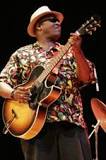
Blues is a music genre and musical form which originated in the Deep South of the United States around the 1860s by African-Americans from roots in African-American work songs and spirituals.
Is blues the mother of all modern music?
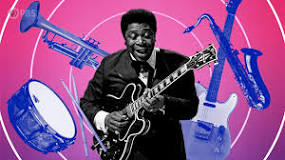
The blues are often referred to as the mother of modern musical forms.
But would you know what genre of blues you're hearing? Blues comes in many different flavors, roughly 25 of them, each with their own nuances and style. Here are a few of the most popular genres of blues music and how you can recognize them from the first note!
How do you identify blues music?
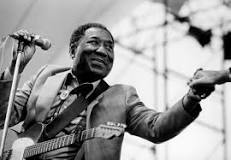
The main features of blues include: specific chord progressions, a walking bass, call and response, dissonant harmonies, syncopation, melisma and flattened 'blue' notes. Blues is known for being microtonal, using pitches between the semitones defined by a piano keyboard.
What's difference between jazz and blues?
Jazz music is often much more lively and upbeat than blues music. Jazz is often associated with swinging and swaying movements, lively atmospheres and even abstract, unpredictable noise. Blue however, is melancholic, sharp and slow – and the format of the music can often sound very similar from one song to the next.
The Most Famous Blues Singers of all Time
- Muddy Waters. ...
- Ma Rainey (1886) ...
- Sister Rosetta Tharpe (1915) ...
- Mamie Smith (1891) ...
- Ray Charles. ...
- Eric Clapton (1945) ...
- B.B. King (1925) ...
- Bessie Smith (1894)
But would you know what genre of blues you're hearing? Blues comes in many different flavors, roughly 25 of them, each with their own nuances and style. Here are a few of the most popular genres of blues music and how you can recognize them from the first note!31-Dec-2019
What is the meaning of Sunday blues?
Cue the Sunday Blues (or Sunday Scaries, depending on who you ask). Many are familiar with the range of emotions and feelings that come with the Sunday Blues: irritability, unease, feeling anxious, restless, and feelings of dread for the impending Monday.
What are Friday blues?
Google 'baba' (Guru) says many people have referred to''Friday blues” as something to do with the hangover of alcohol or —, due to an over happy Friday night. The heavy headed feeling u have on a Saturday morning. The one u need a lemonade to take you out from.
Reggae
Reggae (rɛɡeɪ) is a music genre that originated in Jamaica in the late 1960s. The term also denotes the modern popular music of Jamaica and its diaspora. A 1968 single by Toots and the Maytals, "Do the Reggay" was the first popular song to use the word "reggae", effectively naming the genre and introducing it to a global audience.
While sometimes used in a broad sense to refer to most types of popular Jamaican dance music, the term reggae more properly denotes a particular music style that was strongly influenced by traditional mento as well as American jazz and rhythm and blues, and evolved out of the earlier genres ska and rocksteady.Reggae usually relates news, social gossip, and political commentary. It is instantly recognizable from the counterpoint between the bass and drum downbeat and the offbeat rhythm section. The immediate origins of reggae were in ska and rocksteady; from the latter, reggae took over the use of the bass as a percussion instrument.
Reggae is deeply linked to Rastafari, an Afrocentric religion which developed in Jamaica in the 1930s, aiming at promoting pan-Africanism. Soon after the Rastafarian movement appeared, the international popularity of reggae music became associated with and increased the visibility of Rastafari and spread its gospel throughout the world. Reggae music is an important means of transporting vital messages of Rastafari. The musician becomes the messenger, and as Rastafari see it, "the soldier and the musician are tools for change."
Stylistically, reggae incorporates some of the musical elements of rhythm and blues, jazz, mento (a celebratory, rural folk form that served its largely rural audience as dance music and an alternative to the hymns and adapted chanteys of local church singing), calypso, and also draws influence from traditional African folk rhythms. One of the most easily recognizable elements is offbeat rhythms; staccato chords played by a guitar or piano (or both) on the offbeats of the measure. The tempo of reggae is usually slower paced than both ska and rock steady.
The concept of call and response can be found throughout reggae music. The genre of reggae music is led by the drum and bass. Some key players in this sound are Jackie Jackson from Toots and the Maytals, Carlton Barrett from Bob Marley and the Wailers, Lloyd Brevett from the Skatalites, Paul Douglas from Toots and the Maytals, Lloyd Knibb from the Skatalites,Winston Grennan, Sly Dunbar, and Anthony "Benbow" Creary from the Upsetters.
The bass guitar often plays the dominant role in reggae.
The bass sound in reggae is thick and heavy, and equalized so the upper frequencies are removed and the lower frequencies emphasized. The guitar in reggae usually plays on the offbeat of the rhythm. It is common for reggae to be sung in Jamaican Patois, Jamaican English, and Iyaric dialects. Reggae is noted for its tradition of social criticism and religion in its lyrics, although many reggae songs discuss lighter, more personal subjects, such as love and socializing.
Reggae has spread to many countries around the world, often incorporating local instruments and fusing with other genres. Reggae en Español spread from the Spanish-speaking Central American country of Panama to the mainland South American countries of Venezuela and Guyana then to the rest of South America. Caribbean music in the United Kingdom, including reggae, has been popular since the late 1960s, and has evolved into several subgenres and fusions.
Many reggae artists began their careers in the UK, and there have been a number of European artists and bands drawing their inspiration directly from Jamaica and the Caribbean community in Europe. Reggae in Africa was boosted by the visit of Bob Marley to Zimbabwe in 1980. In Jamaica, authentic reggae is one of the biggest sources of income.
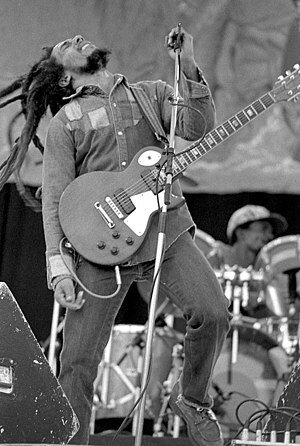 Reggae is a music genre that originated in Jamaica in the late 1960s. The term also denotes the modern popular music of Jamaica and its diaspora
Reggae is a music genre that originated in Jamaica in the late 1960s. The term also denotes the modern popular music of Jamaica and its diasporaHistory
Reggae's roots trace back to the late 1940s and 1950s when the Jamaican recording industry was in its infancy. Mento—a rural-based music that developed from the period of slavery and which came to be influenced by Trinidadian calypso in the urban context of Kingston, was then the popular music.
Style
Reggae is a musical genre developed by Jamaicans of African ancestry in the late 1960s. Reggae bands incorporate musical idioms from many different genres, including mento (a Jamaican folk genre), ska, rocksteady, calypso, and American soul music and rhythm and blues.
Instruments
The instruments that form the foundation of a typical reggae song would be drums, electric bass, electric guitar, and keyboard. However, over the years, other instruments such as horns, brass, and afro-cuban percussion have been introduced to reggae to spice things up.
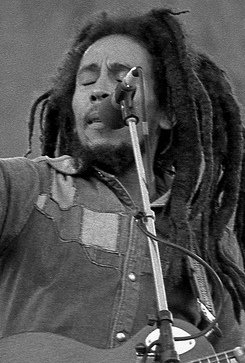
Robert Nesta Marley OM (6 February 1945 – 11 May 1981; baptised in 1980 as Berhane Selassie) was a Jamaican singer, musician, and songwriter. Considered one of the pioneers of reggae, his musical career was marked by fusing elements of reggae, ska, and rocksteady, as well as his distinctive vocal and songwriting style. Marley's contributions to music increased the visibility of Jamaican music worldwide, and made him a global figure in popular culture to this day. Over the course of his career, Marley became known as a Rastafari icon, and he infused his music with a sense of spirituality. He is also considered a global symbol of Jamaican music and culture and identity, and was controversial in his outspoken support for democratic social reforms.[citation needed] In 1976, Marley survived an assassination attempt in his home, which was thought to be politically motivated. He also supported legalization of marijuana, and advocated for Pan-Africanism.
Born in Nine Mile, Jamaica, Marley began his professional musical career in 1963, after forming the Teenagers with Peter Tosh and Bunny Wailer, which after several name changes would become the Wailers. The group released its debut studio album The Wailing Wailers in 1965, which contained the single "One Love", a reworking of "People Get Ready"; the song was popular worldwide, and established the group as a rising figure in reggae.
The Wailers released a further eleven studio albums, and after signing to Island Records the band's name became Bob Marley and the Wailers. While initially employing louder instrumentation and singing, the group began engaging in rhythmic-based song construction in the late 1960s and early 1970s, which coincided with Marley's conversion to Rastafari. Around this time, Marley relocated to London, and the group embodied their musical shift with the release of the album The Best of The Wailers (1971.
Rhythm and blues
Rhythm and blues, frequently abbreviated as R&B or R'n'B, is a genre of popular music that originated in African-American communities in the 1940s.
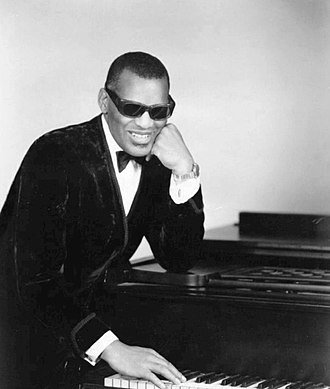
Cultural origins: 1940s–1950s, United States.
Derivative forms: Funk; ska; doo-wop; soul; rock and roll; reggae; disco; beat music; mod revival; hip hop; zydeco
Stylistic origins: Jazz; blues; spirituals; gospel; boogie-woogie; jump blues; swing;
Parent genres: Blues, Pop music, Jazz, Gospel music,
Rhythm and blues, frequently abbreviated as R&B or R'n'B, is a genre of popular music that originated in African-American communities in the 1940s. The term was originally used by record companies to describe recordings marketed predominantly to urban African Americans, at a time when "urbane, rocking, jazz based music ... [with a] heavy, insistent beat" was becoming more popular.
In the commercial rhythm and blues music typical of the 1950s through the 1970s, the bands usually consisted of piano, one or two guitars, bass, drums, one or more saxophones, and sometimes background vocalists. R&B lyrical themes often encapsulate the African-American experience of pain and the quest for freedom and joy, as well as triumphs and failures in terms of relationships, economics, and aspirations.
The term "rhythm and blues" has undergone a number of shifts in meaning. In the early 1950s, it was frequently applied to blues records. Starting in the mid-1950s, after this style of music contributed to the development of rock and roll, the term "R&B" became used to refer to music styles that developed from and incorporated electric blues, as well as gospel and soul music.
From 1960s to 1970s, several British bands such as the Rolling Stones, the Who and the Animals were referred to and promoted as being R&B bands. By the end of the 1970s, the term "rhythm and blues" had changed again and was used as a blanket term for soul and funk. In the late 1980s, a newer style of R&B developed, becoming known as "contemporary R&B". It combines rhythm and blues with elements of pop, soul, funk, disco, hip hop, and electronic music.
Rock and Roll
Rock and roll (often written as rock & roll, rock 'n' roll, or rock 'n roll) is a genre of popular music that evolved in the United States during the late 1940s and early 1950s. It originated from African-American music such as jazz, rhythm and blues, boogie woogie, gospel, as well as country music. While rock and roll's formative elements can be heard in blues records from the 1920s and in country records of the 1930s, the genre did not acquire its name until 1954.
According to journalist Greg Kot, "rock and roll" refers to a style of popular music originating in the United States in the 1950s. By the mid-1960s, rock and roll had developed into "the more encompassing international style known as rock music, though the latter also continued to be known in many circles as rock and roll." For the purpose of differentiation, this article deals with the first definition.
In the earliest rock and roll styles, either the piano or saxophone was typically the lead instrument. These instruments were generally replaced or supplemented by guitar in the middle to late 1950s. The beat is essentially a dance rhythm with an accentuated backbeat, almost always provided by a snare drum.[10] Classic rock and roll is usually played with one or two electric guitars (one lead, one rhythm) and a double bass (string bass). After the mid-1950s, electric bass guitars ("Fender bass") and drum kits became popular in classic rock.
Rock and roll had a polarizing influence on lifestyles, fashion, attitudes, and language. It is often portrayed in movies
What is considered rock and roll?
Rock 'n' roll is a popular music genre that combines elements of rhythm and blues (R&B), jazz, and country music with the addition of electric instruments. Originally associated with youth revolt and transgression, the genre is known for energetic performances, catchy melodies, and often insightful lyrics.
Why is it called rock n Roll?
The story: The term rock 'n' roll derives from the more literal "rocking and rolling", a phrase used by 17th-century sailors to describe the motion of a ship on the sea. Any phrase that is used to suggest rhythmic movement of this sort - particularly by lonely seamen - runs the risk of being purloined as an euphemism.
What did rock and roll do?
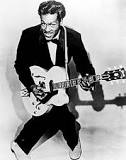
Rock and roll influenced lifestyles, fashion, attitudes, and language. In addition, rock and roll may have contributed to the civil rights movement because both African-American and white American teens enjoyed the music. Many early rock and roll songs dealt with issues of cars, school, dating, and clothing.
The Greatest EVER Rock Song
- 1) LED ZEPPELIN - STAIRWAY TO HEAVEN. ...
- 2) QUEEN - BOHEMIAN RHAPSODY. ...
- 3) LYNYRD SKYNYRD - FREE BIRD. ...
- 4) DEEP PURPLE - SMOKE ON THE WATER. ...
- 5) PINK FLOYD - COMFORTABLY NUMB. ...
- 6) LED ZEPPELIN - KASHMIR. ...
- 7) RAINBOW - STARGAZER. ...
- 8) FREE - ALL RIGHT NOW.

Chuck Berry did in fact invent rock'n'roll. Of course similar musics would have sprung up without him. Elvis was Elvis before he'd ever heard of Chuck Berry. Charles' proto-soul vocals and Brown's everything-is-a-drum were innovations as profound as Berry's.
Who was the first rock artist?
The most widely held belief is that the first rock'n'roll single was 1951's Rocket 88, written by Ike Turner, sung by Jackie Brenston (the saxophone player from Turner's backing band The Kings of Rhythm), and recorded by Sam Phillips, who later went on to found Sun records and discover Elvis Presley.
How did rock and roll change American culture?
Rock and roll had a transformative effect on American society because it encouraged younger people to break out of the more conservative American mold, increased the use of technology in daily life, as well as implemented civil rights movements that bolstered minority groups and races.
Why was rock n roll so popular in the 1950s?

Another reason rock and roll spread so quickly was because of the advancement in technology. Electric guitars could play music louder and recording studios used the latest technology to improve the sound on radios and record players everywhere. Television also influenced the spread of rock and roll.
Who first used rock and roll?
Jockey Alan Freed
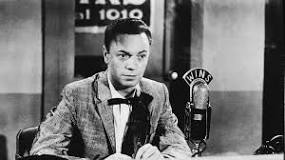
Cleveland disc jockey Alan Freed, who coined the phrase 'rock 'n roll,' born in 1921. Cleveland disc jockey Alan Freed, who introduced the phrase “rock 'n' roll” on mainstream radio in the early 1950s was born on Dec.
Who made rock and roll popular?
Some of the early Rock and Roll artists were Elvis Presley, Chuck Berry, Little Richard, Jerry Lee Lewis, Fats Domino, Buddy Holly, and Bill Haley and the Comets. The first number-one single of Rock and Roll was "Rock Around the Clock" by Bill Haley and the Comets. Rock and Roll emerged in the early 1950s.
How did rock music start?
Rock music first grew out of the rock'n'roll movement of the 1940s and 50s, which itself was inspired by country and African-American rhythm and blues from the 1920s and 30s.
Why is rock music popular?
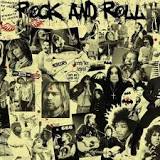
Rock has always been against everything, sometimes just out of the fun, like the punk scene general attitude. Rock music talks to the audience's emotions. The more complex the music is, the more progressive the audience will be. These songs are written from the heart, from the human emotional side.
What defines the rock genre?
Most rock music emphasizes the pentatonic scale, a bare-bones scale that comes from blues music. Even a novice guitarist can create a basic rock sound by just playing the minor pentatonic scale on a distorted electric guitar. That sound can be used in any of rock's many subgenres and not seem out of place.
What defines a rock song?
Rock music is a type of pop music that developed out of rock'n'roll in the 1960s and 1970s. It is based around amplified instruments, especially the electric guitar and electric bass, and is characterized by a strong bass line and driving rhythms.
What is the coolest rock song?
31 Best Classic Rock Songs Ever Made
- Baba O' Riley – The Who. ...
- Smoke on the Water – Deep Purple. ...
- Comfortably Numb – Pink Floyd. ...
- Roadhouse Blues – The Doors. ...
- Purple Haze – Jimi Hendrix. ...
- Bohemian Rhapsody – Queen. ...
- Another Brick on the Wall Pt. ...
- Rock You Like a Hurricane – Scorpions.
Yet “It's a Small World,” also known as “It's a Small, Small World” and “It's a Small World (After All),” is very likely the most played song in music history — nearly 50 million times.
What is considered the greatest song ever?
The Best Songs Of All Time—According To Critics And Fans
- 'Imagine' — John Lennon. Getty Images.
- 'Hey Jude' — The Beatles. ...
- '(I Can't Get No) Satisfaction' — The Rolling Stones. ...
- 'Yesterday' — The Beatles. ...
- 'Good Vibrations' — The Beach Boys. ...
- 'Smells Like Teen Spirit' — Nirvana. ...
- 'Johnny B. ...
- 'I Want To Hold Your Hand' — The Beatles.
Elvis Presley
Elvis Presley is, quite simply, the King of Rock & Roll. In 1954, the performer kicked off a musical revolution by modernizing traditional genres such as blues, country and bluegrass for contemporary (and more youthful) audiences.
When did rock become popular?
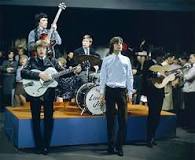
Rock, also called rock and roll, rock & roll, or rock 'n' roll, form of popular music that emerged in the 1950s. It is certainly arguable that by the end of the 20th century rock was the world's dominant form of popular music.
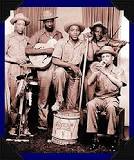
One of the first rappers at the beginning of the hip hop period, at the end of the 1970s, was also hip hop's first DJ, DJ Kool Herc. Herc, a Jamaican immigrant, started delivering simple raps at his parties, which some claim were inspired by the Jamaican tradition of toasting.
Chuck Berry
| Born | Charles Edward Anderson BerryOctober 18, 1926 St. Louis, Missouri, U.S. |
| Died | March 18, 2017 (aged 90) near Wentzville, Missouri, U.S. |
| Resting place | Bellerive Gardens Cemetery, St. Louis |
| Other names | Father of Rock N' Roll |
Who invented music?
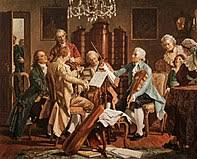
Many cultures have their own mythical origins on the creation of music. Specific figures are sometimes credited with inventing music, such as Jubal in Christian mythology, the legendary Shah Jamshid in Persian/Iranian mythology, the goddess Saraswati in Hinduism, and the muses in Ancient Greek mythology.
Bluegrass music is a genre of American roots music that developed in the 1940s in the Appalachian region of the United States. The genre derives its name from the band Bill Monroe and the Blue Grass Boys.
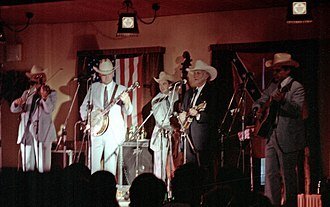
Bluegrass music is a genre of American roots music that developed in the 1940s in the Appalachian region of the United States. The genre derives its name from the band Bill Monroe and the Blue Grass Boys. Like mainstream country music, it largely developed out of old-time string music, though in contrast, bluegrass is traditionally played exclusively on acoustic instruments and also has roots in traditional English, Scottish, and Irish ballads and dance tunes as well as in blues and jazz. Bluegrass was further developed by musicians who played with Monroe, including 5-string banjo player Earl Scruggs and guitarist Lester Flatt. Monroe characterized the genre as: "Scottish bagpipes and ole-time fiddlin'. It's a part of Methodist, Holiness and Baptist traditions. It's blues and jazz, and it has a high lonesome sound."
Bluegrass features acoustic stringed instruments and emphasizes the off-beat. Notes are anticipated, in contrast to laid back blues where notes are behind the beat, which creates the higher energy characteristic of bluegrass. In bluegrass, as in some forms of jazz, one or more instruments each takes its turn playing the melody and improvising around it, while the others perform accompaniment; this is especially typified in tunes called breakdowns. This is in contrast to old-time music, in which all instruments play the melody together or one instrument carries the lead throughout while the others provide accompaniment. Breakdowns are often characterized by rapid tempos and unusual instrumental dexterity and sometimes by complex chord changes.
Country music
Country (also called country and western) is a genre of popular music that originated with blues, church music such as Southern gospel and spirituals, old-time, and American folk music forms including Appalachian, Cajun, Creole, and the cowboy Western music styles of New Mexico, Red Dirt, Tejano, and Texas country. Its popularized roots originate in the Southern and Southwestern United States of the early 1920s.
Country music often consists of ballads and dance tunes (most commonly known as "Honky Tonk music") with generally simple forms, folk lyrics, and harmonies often accompanied by string instruments such as electric and acoustic guitars, steel guitars (such as pedal steels and dobros), banjos, and fiddles as well as harmonicas. Blues modes have been used extensively throughout its recorded history.
The term country music gained popularity in the 1940s in preference to hillbilly music; it came to encompass Western music, which evolved parallel to hillbilly music from similar roots, in the mid-20th century. In 2009, in the United States, country music was the most listened to rush hour radio genre during the evening commute, and second most popular in the morning commute.
The term country music is used today to describe many styles and subgenres. The origins of country music are found in the folk music of working class Americans and blue-collar American life. It has historical roots in the indigenous music of North America, Celtic music, early music of the British Isles, jota, Irish traditional music, singing cowboys, corrido, ranchera, norteño, French folk music, African-American music, and other traditional folk music traditions.